Caprenin is a fat substitute designed for lowering the caloric content of food. Structurally, it resembles normal food fat, being made up of glycerol and fatty acids (behenic, capric, and caprylic acids). Caprenin contains about 4 kcal per gram, or about half the energy in traditional fats and oils. Caloric reduction results, in part, from incomplete absorption of the unusual fatty acids.
A fat substitute is a food product with the same functions, stability, physical, and chemical characteristics as regular fat, with fewer Calories per gram than fat. They are utilized in the production of low fat and low calorie foods.

Glycerol is a simple polyol compound. It is a colorless, odorless, viscous liquid that is sweet-tasting and non-toxic. The glycerol backbone is found in many lipids which are known as glycerides. It is widely used in the food industry as a sweetener and humectant and in pharmaceutical formulations. Glycerol has three hydroxyl groups that are responsible for its solubility in water and its hygroscopic nature.
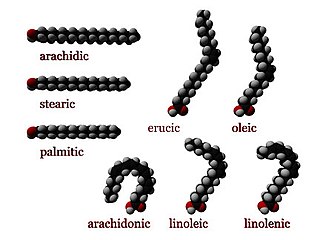
In chemistry, particularly in biochemistry, a fatty acid is a carboxylic acid with a long aliphatic chain, which is either saturated or unsaturated. Most naturally occurring fatty acids have an unbranched chain of an even number of carbon atoms, from 4 to 28. Fatty acids are usually not found in organisms, but instead as three main classes of esters: triglycerides, phospholipids, and cholesterol esters. In any of these forms, fatty acids are both important dietary sources of fuel for animals and they are important structural components for cells.
Caprenin was launched by Procter & Gamble as a cocoa butter replacement, but it proved difficult to use and appeared to increase serum cholesterol slightly, resulting in its withdrawal from the market in the mid-'90s.

The Procter & Gamble Company (P&G) is an American multi-national consumer goods corporation headquartered in downtown Cincinnati, Ohio, founded in 1837 by British American William Procter and Irish American James Gamble. It specializes in a wide range of personal health/consumer health, and personal care and hygiene products; these products are organized into several segments including Beauty; Grooming; Health Care; Fabric & Home Care; and Baby, Feminine & Family Care. Before the sale of Pringles to the Kellogg Company, its product portfolio also included foods, snacks, and beverages.
![Cocoa butter Pale-yellow, edible [[vegetable fat]] extracted from the [[cocoa bean]]](https://upload.wikimedia.org/wikipedia/commons/thumb/d/df/Cocoa_butter_p1410148.JPG/320px-Cocoa_butter_p1410148.JPG)
Cocoa butter, also called theobroma oil, is a pale-yellow, edible vegetable fat extracted from the cocoa bean. It is used to make chocolate, as well as some ointments, toiletries, and pharmaceuticals. Cocoa butter has a cocoa flavor and aroma. Its melting point is just below human body temperature.
It is used as a reduced-calorie substitute in soft candies and confectionery coatings.

A triglyceride is an ester derived from glycerol and three fatty acids. Triglycerides are the main constituents of body fat in humans and other animals, as well as vegetable fat. They are also present in the blood to enable the bidirectional transference of adipose fat and blood glucose from the liver, and are a major component of human skin oils.

Vegetable oils, or vegetable fats, are fats extracted from seeds, or less often, from other parts of fruits. Like animal fats, vegetable fats are mixtures of triglycerides. Soybean oil, rapeseed oil, and cocoa butter are examples of fats from seeds. Olive oil, palm oil, and rice bran oil are example of fats from other parts of fruits. In common usage, vegetable oil may refer exclusively to vegetable fats which are liquid at room temperature.
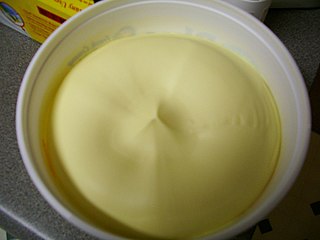
Margarine is a spread used for flavoring, baking, and cooking, that was first made in France in 1869. It was created by Hippolyte Mège-Mouriès in response to a challenge by Emperor Napoleon III to create a butter substitute from beef tallow for the armed forces and lower classes. First named oleomargarine from Latin for oleum and Greek for margarite, it was later named margarine.
Rancidity is the complete or incomplete oxidation or hydrolysis of fats and oils when exposed to air, light, or moisture or by bacterial action, resulting in unpleasant taste and odor. Specifically, it is the hydrolysis or autoxidation of fats into short-chain aldehydes and ketones, which are objectionable in taste and odor. When these processes occur in food, undesirable odors and flavors can result. In certain cases, however, the flavors can be desirable. In processed meats, these flavors are collectively known as warmed-over flavor. Rancidification can also detract from the nutritional value of food, as some vitamins are sensitive to oxidation. Similar to rancidification, oxidative degradation also occurs in other hydrocarbons, such as lubricating oils, fuels, and mechanical cutting fluids.
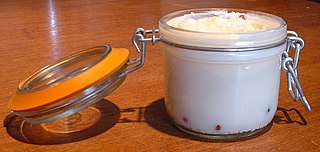
Tallow is a rendered form of beef or mutton fat, and is primarily made up of triglycerides. It is solid at room temperature. Unlike suet, tallow can be stored for extended periods without the need for refrigeration to prevent decomposition, provided it is kept in an airtight container to prevent oxidation.

Coconut oil, or copra oil, is an edible oil extracted from the kernel or meat of mature coconuts harvested from the coconut palm. It has various applications. Because of its high saturated fat content, it is slow to oxidize and, thus, resistant to rancidification, lasting up to six months at 24 °C (75 °F) without spoiling.

Trans fat, also called trans-unsaturated fatty acids or trans fatty acids, is a type of unsaturated fat that occurs in small amounts in nature, but became widely produced industrially from vegetable fats starting in the 1950s for use in margarine, snack food, packaged baked goods, and for frying fast food.
An unsaturated fat is a fat or fatty acid in which there is at least one double bond within the fatty acid chain. A fatty acid chain is monounsaturated if it contains one double bond, and polyunsaturated if it contains more than one double bond.

Glycerides, more correctly known as acylglycerols, are esters formed from glycerol and fatty acids.
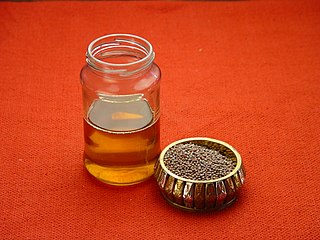
The term mustard oil is used for two different oils that are made from mustard seeds:
Biodiesel production is the process of producing the biofuel, biodiesel, through the chemical reactions transesterification and esterification. This involves vegetable or animal fats and oils being reacted with short-chain alcohols. The alcohols used should be of low molecular weight, ethanol being one of the most used for its low cost. However, greater conversions into biodiesel can be reached using methanol. Although the transesterification reaction can be catalyzed by either acids or bases the most common means of production is base-catalyzed transesterification. This path has lower reaction times and catalyst cost than those posed by acid catalysis. However, alkaline catalysis has the disadvantage of its high sensitivity to both water and free fatty acids present in the oils.
In biochemistry and nutrition, monounsaturated fatty acids (abbreviated MUFAs, or more plainly monounsaturated fats) are fatty acids that have one double bond in the fatty acid chain with all of the remainder carbon atoms being single-bonded. By contrast, polyunsaturated fatty acids (PUFAs) have more than one double bond.

Polyunsaturated fats are fats in which the constituent hydrocarbon chain possesses two or more carbon–carbon double bonds. Polyunsaturated fat can be found mostly in nuts, seeds, fish, seed oils, and oysters. "Unsaturated" refers to the fact that the molecules contain less than the maximum amount of hydrogen. These materials exist as cis or trans isomers depending on the geometry of the double bond.
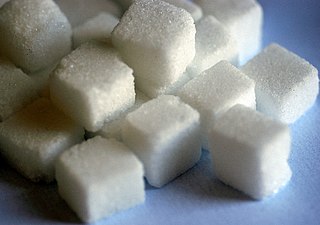
In human nutrition, the term empty calories applies to foods and beverages composed primarily or solely of sugar, fats or oils, or alcohol-containing beverages. An example is carbonated soft drinks. These supply food energy but little or no other nutrition in the way of vitamins, minerals, protein, fiber, or essential fatty acids. Fat contributes nine calories per gram, ethanol seven calories, sugar four calories. The U.S. Department of Agriculture (USDA) advises, "A small amount of empty calories is okay, but most people eat far more than is healthy." The phrase is derived from low nutrient density, which is the proportion of nutrients in a food relative to its energy content.

Soybean oil is a vegetable oil extracted from the seeds of the soybean. It is one of the most widely consumed cooking oils. As a drying oil, processed soybean oil is also used as a base for printing inks and oil paints.
Interesterified fat is a type of oil where the fatty acids have been moved from one triglyceride molecule to another. This is generally done to modify the melting point, slow rancidification and create an oil more suitable for deep frying or making margarine with good taste and low saturated fat content. It is not the same as partial hydrogenation which produces trans fatty acids, but interesterified fats used in the food industry can come from hydrogenated fat, for simplicity and frugality.

Cooking oil is plant, animal, or synthetic fat used in frying, baking, and other types of cooking. It is also used in food preparation and flavouring not involving heat, such as salad dressings and bread dips, and in this sense might be more accurately termed edible oil.



![Cocoa butter Pale-yellow, edible [[vegetable fat]] extracted from the [[cocoa bean]]](https://upload.wikimedia.org/wikipedia/commons/thumb/d/df/Cocoa_butter_p1410148.JPG/320px-Cocoa_butter_p1410148.JPG)









